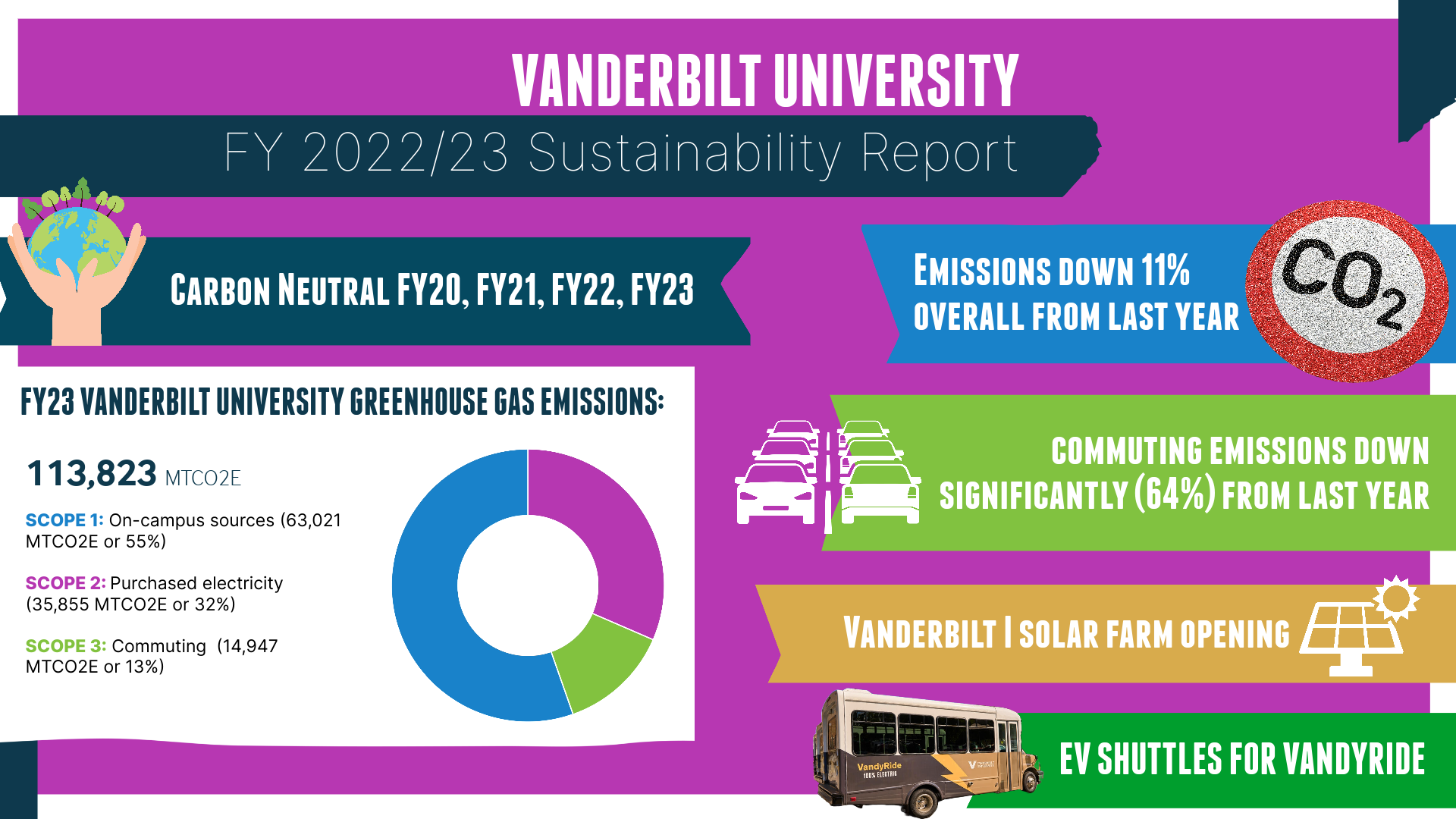Vanderbilt greenhouse gas emissions drop 11 percent since last year and 35 percent since 2016, sustainability report shows
- Vanderbilt University’s greenhouse gas emissions have dropped 11 percent overall since fiscal year 2022. Emissions have dropped 35 percent since 2016 (the first year Vanderbilt reported emissions separately from VUMC).
- Commuting emissions decreased 64 percent between FY22 and FY23 due to increases in telecommuting and greater insights into commuting behaviors.
- Full details can be found in the FY23 Sustainability Report.
“We’re proud of the progress we’ve made on sustainability—but we’re not satisfied,” Chancellor Daniel Diermeier said. “We will continue to implement innovative sustainability practices and our own innovations to ensure that the ways in which we power our campus, move our people, and build every new square foot is as efficient and as sustainable as possible. Using our own campus as a lab we can develop and implement solutions that can be models for others.”
Vanderbilt University’s greenhouse gas emissions have dropped 11 percent overall since fiscal year 2022. Emissions have dropped 35 percent since 2016 (the first year Vanderbilt reported emissions separately from VUMC). The latest annual sustainability report, released by Environmental Health, Safety and Sustainability in the Division of Administration, details Vanderbilt’s fiscal year 2023 sustainability efforts that support the university’s overall sustainability goals.
“Sustainability is an integral value and principle embedded in our campuswide initiatives,” said Eric Kopstain, vice chancellor for administration. “This report reflects the collaborative efforts among our students, faculty and staff to further our sustainability goals. I look forward to continuing the momentum reflected in the annual report in the years ahead.”
As Vanderbilt continues to prioritize sustainability, this annual report provides a means for measuring progress toward reducing campus emissions.
VIEW THE FY23 SUSTAINABILITY REPORT >>
Carbon neutrality through solar energy collaborations
Vanderbilt maintained its carbon neutrality in FY23 through a portfolio approach with the organization Clearloop and the Vanderbilt I Solar Farm, the university’s first solar farm investment, in Bedford County, Tennessee. Vanderbilt first became carbon neutral in FY20, decades ahead of its initial goal.
Clearloop provides offsets for Vanderbilt’s carbon footprint by investing in the development of solar energy projects that will expand access to clean energy in the Southeast. Vanderbilt’s investment initially supports a solar farm in Panola County, Mississippi, in the town of Batesville—a community at the intersection of the Mississippi Delta and the Appalachian foothills. This solar farm will provide access to clean energy to approximately 1,000 Panola County homes. Vanderbilt will receive the carbon offset credits for the life of this solar project. Two more solar farms are planned as part of Vanderbilt’s collaboration with Clearloop.
Vanderbilt also opened its first solar farm through the Green Invest Program, the Vanderbilt I Solar Farm, in April 2023. Renewable Energy Certificates from the Vanderbilt I Solar Farm offset approximately 70 percent of the university’s annual indirect greenhouse gas emissions from electricity purchased through Nashville Electric Service, or the equivalent of enough power to help serve more than 6,000 homes for one year.
The university’s greenhouse gas emissions are split among three primary sources:
- 55 percent from on-campus natural gas use
- 32 percent from electricity purchased from Nashville Electric Service
- 13 percent from commuting, air travel, recycling and waste disposal
“Our campus community, including faculty, staff and students, continues to work together to further our sustainability goals,” said Andrea George, assistant vice chancellor for environmental health, safety and sustainability. “This report is reflective of our combined achievements. We will all continue to build on this progress together in the years ahead, and I look forward to our continued successes.”
Commuting greenhouse gas emissions decreased 64 percent between FY21 and FY23
The report found that Vanderbilt made significant progress in reducing emissions from commuting, which decreased 64 percent between FY22 and FY23 due to increases in telecommuting and greater insights into commuting behaviors. In addition, VU’s GHG emissions per gross square foot has dropped by 34 percent over three years, despite a growth of 950,000 square feet over the same period.
Additional highlights in the report
TRANSPORTATION AND MOBILITY
- In 2023, Vanderbilt became the first university in Tennessee to launch an all-electric multi-vehicle shuttle fleet for VandyRide. The transition to these EV shuttles will help Vanderbilt further reduce its direct emissions.
- The MoveVU program received the Sustainable Transportation Award at the Tennessee Sustainable Transportation Forum and Expo.
CAMPUS DINING
- Beginning in 2023, Campus Dining partnered with ReusePass to continue a reusable container program. ReusePass offers a straightforward process that empowers participants to effortlessly make eco-conscious dining choices and help curb single-use plastic waste.
- Campus Dining also prioritizes local purchasing to reduce our carbon footprint and support the local community.
- Inside the many campus dining halls, Campus Dining uses tower gardens to grow hyper-local produce, including lettuce and herbs. This produce is then used inside the Commons Dining Hall, Rothschild College and Zeppos College for meals like sandwiches and pizza.
- Another local vendor providing produce to campus is HydroHouse Farms, founded by Vanderbilt Alumnus Hassan Sharaff. HydroHouse Farms specialized in year-round hydroponic production of leafy greens and uses sustainable practices to reduce the amount of water needed for growing the produce by 90 percent compared to traditional farming techniques.
To learn more about these and other areas of progress in sustainability on campus, view the FY23 Sustainability Report.

